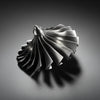
The Advantages of High-Speed Milling Aluminum
Modern industry demands rapid manufacturing, with monthly rising needs for rapid prototypes or custom precision parts. Customers expect faster order fulfillment and require components with higher precision than ever before. Aluminum, one of the most widely used alloys in production, offers lightweight properties while being strong, durable, and corrosion-resistant.
High-speed milling stands as one of the CNC aluminum machining’s most successful methods. The primary distinction from conventional milling lies in its significantly higher spindle speeds, enabling operators to increase cutting feed rates. This approach delivers substantial advantages.

Exposing Hidden Waste in CNC Machining: Reduce Your Part Processing Time by 90%!
As a procurement manager for components, do you often face significant discrepancies in CNC machining quotes? Behind the price differences lies a major culprit—processing waste. This includes material loss, tool scrapping, rework, downtime, and more. Ultimately, all waste is reflected in your quoted price.
Competing by squeezing profit margins is unsustainable. The real solution is waste reduction! In this blog, we openly share our factory’s core strategies and real data for minimizing CNC waste—revealing why we offer greater value.

How Precision CNC Machining Shapes the Soul of Automotive Lighting
Headlights are not only simple lighting tools, but also the soul of window on the car. Unique headlight design is the core of brand recognition. It is also the intersection of safety and artistically.
Designers are constantly adjusting the aesthetics of the curved surface, optical efficiency and aerodynamic limits on car lights. Purchasing engineers are also looking for the best balance between cost, quality and delivery time.
Behind these stringent goals, there is a silent cornerstone: CNC machining.

Quote Price Increases: 10 Details May You Ignore in CNC Machining
Do you think CNC machining is just loading a drawing and pressing "go"? Think again. While 5-Axis CNC machines are marvels of automation, the difference between a good part and an amazing part often lies in subtle, easily overlooked details. Here are 10 critical factors that might be you ignore before.

5 Points Tell You Why Manual Machining Still Dominates in the Age of CNC Precision
The Unreplaceable Value of Manual Skills in Digital Manufacturing
Walk into any CNC machine factory, and you’ll see lines of CNC machines well-organized operation. Yet in the corners are benches where master craftsman no robot can replace. Different with predictions of total automation, 73% of high-precision manufacturers retain specialized manual department—not to commemorate the spirit of craftsmanship, but it has a key factor to improve product precision. In aerospace, medical and automatic industrial, these experts deliver what machines cannot.

CNC Machining Replaces Traditional Machining Methods, have Efficiency Really been Enhanced?
In today's world, when people talk about machining, they often think of CNC rather than traditional machine. However, are traditional machines facing the fate of being eliminated? How efficient are traditional machines in the CNC times? I will analyze the differences between traditional machines and CNC from the accuracy, cost, and automation degree, as well as their current application scenarios.

Aluminum 6061 vs 7075: The Definitive Guide to Choosing Your Alloy
Introduction: The Critical Crossroads
In precision engineering, selecting the right aluminum alloy can mean the difference between optimal performance and catastrophic failure. 6061 and 7075 – two of the most widely used alloys – sit at opposite ends of the aluminum spectrum. While 6061 offers versatility and economy, 7075 delivers aerospace-grade strength. Yet misapplying either can lead to costly redesigns, premature failures, or bloated budgets.

Demystifying Surface Roughness Value: The Key to Functional Precision
Why Surface Roughness Matters
Surface roughness quantifies microscopic peaks and valleys on machined parts. It directly impacts:
-
Functional Performance: Friction, wear, sealing, lubrication retention
-
Aesthetics: Visual appearance and light reflection
-
Manufacturing Cost: Finer finishes require additional operations (grinding, polishing)





